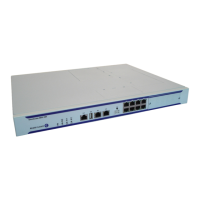Virtual Private Routed Network Services
7750 SR OS Services Guide Page 979
The operational state is a read-only variable and the only controlling variables are the address and
admin states. The address and admin states are independent and can be set independently. If an
interface is in an adminstratively up state and an address is assigned, it becomes operationally up and
the protocol interfaces and the MPLS LSPs associated with that IP interface will be reinitialized.
ip-address — The IP address of the IP interface. The ip-address portion of the address command
specifies the IP host address that will be used by the IP interface within the subnet. This address
must be unique within the subnet and specified in dotted decimal notation. Allowed values are IP
addresses in the range 1.0.0.0 – 223.255.255.255 (with support of /30 subnets).
/ — The forward slash is a parameter delimiter and separates the ip-address portion of the IP address
from the mask that defines the scope of the local subnet. No spaces are allowed between the ip-
address, the “/” and the mask-length parameter. If a forward slash is not immediately following
the ip-address, a dotted decimal mask must follow the prefix.
mask-length — The subnet mask length when the IP prefix is specified in CIDR notation. When the
IP prefix is specified in CIDR notation, a forward slash (/) separates the ip-address from the
mask-length parameter. The mask length parameter indicates the number of bits used for the
network portion of the IP address; the remainder of the IP address is used to determine the host
portion of the IP address. Allowed values are integers in the range 0 – 30. Note that a mask length
of 32 is reserved for system IP addresses.
mask — The subnet mask in dotted decimal notation. When the IP prefix is not specified in CIDR
notation, a space separates the ip-address from a traditional dotted decimal mask. The mask
parameter indicates the complete mask that will be used in a logical ‘AND’ function to derive the
local subnet of the IP address. Allowed values are dotted decimal addresses in the range
128.0.0.0 – 255.255.255.252. Note that a mask of 255.255.255.255 is reserved for system IP
addresses.
broadcast — The optional broadcast parameter overrides the default broadcast address used by the
IP interface when sourcing IP broadcasts on the IP interface. If no broadcast format is specified
for the IP address, the default value is host-ones which indictates a subnet broadcast address. Use
this parameter to change the broadcast address to all-ones or revert back to a broadcast address of
host-ones.
The broadcast format on an IP interface can be specified when the IP address is assigned or
changed.
This parameter does not affect the type of broadcasts that can be received by the IP interface. A
host sending either the local broadcast (all-ones) or the valid subnet broadcast address (host-
ones) will be received by the IP interface.
Default host-ones
all-ones — The all-ones keyword following the
broadcast parameter specifies the broadcast address
used by the IP interface for this IP address will be 255.255.255.255, also known as the local
broadcast.
host-ones — The host-ones keyword following the broadcast parameter specifies that the broadcast
address used by the IP interface for this IP address will be the subnet broadcast address. This is
an IP address that corresponds to the local subnet described by the ip-address and the mask-
length or mask with all the host bits set to binary one. This is the default broadcast address used
by an IP interface.
The broadcast parameter within the address command does not have a negate feature, which is
usually used to revert a parameter to the default value. To change the broadcast type to host-
ones after being changed to all-ones, the address command must be executed with the
broadcast parameter defined.

